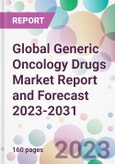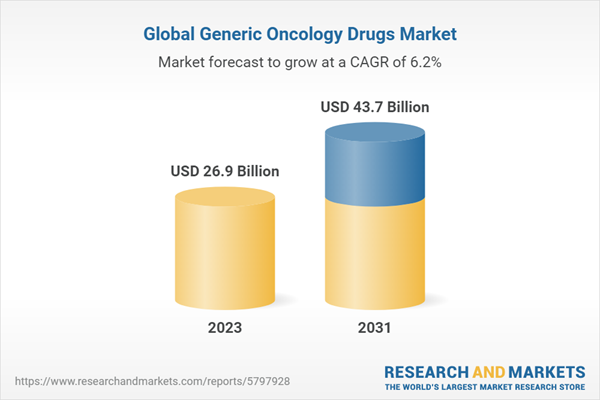The global generic oncology drugs market value was USD 25.3 billion in 2022, driven by the increasing prevalence of cancer across the globe. The market size is anticipated to grow at a CAGR of 6.2% during the forecast period of 2023-2031 to achieve a value of USD 43.7 billion by 2031.
The global generic oncology drugs market is witnessing significant growth due to the rising prevalence of cancer worldwide and increasing demand for cost-effective treatments. Additionally, the introduction of biosimilars in the oncology drug market is expected to drive market growth in the coming years
However, the high cost of research and development activities and the stringent regulatory policies regarding drug approval are the major factors that may hamper the growth of the market. In addition, the limited availability of oncology drugs in underdeveloped and developing countries may also restrain market growth.
Despite these challenges, the market is expected to grow significantly due to the increasing focus of key players on developing generic versions of cancer drugs and the rising demand for personalized medicine in cancer treatment. The emergence of new technologies such as precision medicine and immunotherapy is also expected to boost the market growth in the coming years.
The global generic oncology drugs market is driven by factors such as increasing prevalence of cancer, patent expiry of blockbuster drugs, and rising demand for cost-effective treatment options. In addition, the advent of new technologies in drug delivery and the increasing trend of mergers and acquisitions among key players in the market are expected to create growth opportunities.
However, the stringent regulatory requirements for approval and quality control of generic drugs and the high cost of research and development of new drugs are some of the major factors that may restrain the growth of the global generic oncology drugs market.
Overall, the global generic oncology drugs market is projected to exhibit significant growth in the coming years, driven by increasing demand for cost-effective cancer treatment options, rising research and development activities, and increasing adoption of advanced technologies.
Generic Oncology Drugs Introduction
Generic Oncology Drugs refer to the pharmaceuticals that are used to prevent, diagnose, and treat various types of cancer. These drugs are generally produced after the patent expiration of their branded counterparts, making them more affordable for patients.The global generic oncology drugs market is witnessing significant growth due to the rising prevalence of cancer worldwide and increasing demand for cost-effective treatments. Additionally, the introduction of biosimilars in the oncology drug market is expected to drive market growth in the coming years
However, the high cost of research and development activities and the stringent regulatory policies regarding drug approval are the major factors that may hamper the growth of the market. In addition, the limited availability of oncology drugs in underdeveloped and developing countries may also restrain market growth.
Despite these challenges, the market is expected to grow significantly due to the increasing focus of key players on developing generic versions of cancer drugs and the rising demand for personalized medicine in cancer treatment. The emergence of new technologies such as precision medicine and immunotherapy is also expected to boost the market growth in the coming years.
Generic Oncology Drugs Market Scenario
Generic oncology drugs are low-cost alternatives to their brand-name counterparts, designed to treat cancer. These drugs are equivalent in terms of dosage, strength, route of administration, quality, and intended use as the innovator drugs but are sold at lower prices. These drugs are widely available in various formulations, including injectables, capsules, tablets, and liquids.The global generic oncology drugs market is driven by factors such as increasing prevalence of cancer, patent expiry of blockbuster drugs, and rising demand for cost-effective treatment options. In addition, the advent of new technologies in drug delivery and the increasing trend of mergers and acquisitions among key players in the market are expected to create growth opportunities.
However, the stringent regulatory requirements for approval and quality control of generic drugs and the high cost of research and development of new drugs are some of the major factors that may restrain the growth of the global generic oncology drugs market.
Overall, the global generic oncology drugs market is projected to exhibit significant growth in the coming years, driven by increasing demand for cost-effective cancer treatment options, rising research and development activities, and increasing adoption of advanced technologies.
Generic Oncology Drugs Market Segmentations
Market Breakup by Molecule Type
- Large Molecule
- Small Molecule
Market Breakup by Route of Administration
- Oral
- Parentals
Market Breakup by Distribution Channel
- Hospital Pharmacy
- Online Pharmacy
- Retail Pharmacy
Market Breakup by Region
North America
- United States of America
- Canada
Europe
- United Kingdom
- Germany
- France
- Italy
- Others
Asia Pacific
- China
- Japan
- India
- ASEAN
- Australia
- Others
Latin America
- Brazil
- Argentina
- Mexico
- Others
Middle East and Africa
- Saudi Arabia
- United Arab Emirates
- Nigeria
- South Africa
- Others
Key Trends in the Generic Oncology Drugs Market
Some key trends in the generic oncology drugs market are:- Increasing prevalence of cancer: As the incidence of cancer continues to rise globally, the demand for effective and affordable treatment options is also increasing. This is driving the growth of the generic oncology drugs market
- Growing focus on cost containment: With rising healthcare costs, payers and providers are increasingly focused on cost containment measures. Generic drugs offer a more cost-effective alternative to branded drugs, which is driving the growth of the generic oncology drugs market
- Patent expirations of branded drugs: The patent expirations of several blockbuster oncology drugs are leading to the entry of generic versions of these drugs. This is creating opportunities for generic drug manufacturers to enter the market and gain market share
- Increasing competition among generic drug manufacturers: As more players enter the market, competition among generic drug manufacturers is increasing. This is leading to price erosion, which is a major challenge for companies operating in this market
- Growing demand for biosimilars: Biosimilars are gaining traction in the oncology market, as they offer a more affordable alternative to expensive biologics. This is driving the growth of the generic oncology drugs market
Generic Oncology Drugs Market: Competitor Landscape
The key features of the market report include patent analysis, grants analysis, clinical trials analysis, funding and investment analysis, partnerships, and collaborations analysis by the leading key players. The major companies in the market are as follows:- Novartis AG
- Pfizer Inc
- GlaxoSmithKline plc
- Teva Pharmaceutical Industries Ltd
- Merk & Company, Inc
- Aurobindo Pharma
- Hikma Pharmaceuticals PLC
- Mylan N.V
- NATCO Pharma Limited
- CELGENE CORPORATION
Table of Contents
1 Preface
3 Cancer Overview
4 Patient Profile
5 Cancer Epidemiology Analysis
6 Global Generic Oncology Drugs Market Overview
7 Global Generic Oncology Drugs Market Landscape
8 Generic Oncology Drug Challenges and Unmet Needs
10 Global Generic Oncology Drugs Market Dynamics
11 Global Generic Oncology Drugs Market Segmentation
12 North America Generic Oncology Drugs Market
13 Europe Generic Oncology Drugs Market
14 Asia Pacific Generic Oncology Drugs Market
15 Latin America Generic Oncology Drugs Market
16 Middle East and Africa Generic Oncology Drugs Market
17 Patent Analysis
18 Grants Analysis
19 Clinical Trials Analysis
20 Funding Analysis
21 Partnership and Collaborations Analysis
22 Regulatory Framework
23 Supplier Landscape
24 Global Generic Oncology Drugs Market - Distribution Model (Additional Insight)
26 Company Competitiveness Analysis (Additional Insight)
27 Payment Methods (Additional Insight)
Companies Mentioned
- Novartis AG
- Pfizer Inc.
- GlaxoSmithKline plc
- Teva Pharmaceutical Industries Ltd.
- Merk & Company, Inc.
- Aurobindo Pharma.
- Hikma Pharmaceuticals plc
- Mylan N.V.
- Natco Pharma Limited
- Celgene Corporation
Methodology

LOADING...
Table Information
| Report Attribute | Details |
|---|---|
| No. of Pages | 160 |
| Published | May 2023 |
| Forecast Period | 2023 - 2031 |
| Estimated Market Value ( USD | $ 26.9 Billion |
| Forecasted Market Value ( USD | $ 43.7 Billion |
| Compound Annual Growth Rate | 6.2% |
| Regions Covered | Global |
| No. of Companies Mentioned | 10 |









